Observers affecting reality? The Double Slit Experiment
Posted by Youssef Moawad on: 09/05/2017, in Physics
Introduction
The modern double slit experiment demonstrates one of the weirdest, and perhaps fundamentally the only weird, phenomenon about quantum mechanics. Do observers affect reality? Are particles "conscious" of what's happening around them? In this article, I'll be exploring these concepts, starting off by talking about waves, Young's original double slit experiment and finally the modern double slit experiment performed with electrons. Oh, by the way did I mention wave-particle duality! Wave-particle duality is another one of those concepts that make quantum mechanics weird, frustrating and beautiful! And the double slit experiment essentially proves that matter can indeed exist as a wave, in addition to providing insight into other things.
Fair warning: I do not claim to be an expert on this topic. What I am discussing here is what I have come to understand about the modern double slit experiment through my own personal research into the topic and my studies at university. In addition, since quantum mechanics can be interpreted in many different ways, I will be expressing what I think the results of the double slit experiment could possibly mean.
My ultimate goal with this article is to introduce the reader to some of the weird phenomena that accompany quantum mechanics without assuming prior quantum physics knowledge on their part.
In order to understand the modern double slit experiment, we need to first understand the results of Thomas Young's double slit experiment which he performed in 1801, showing that light can behave as a wave, rather than as a particle (of course Einstein later showed that it can also behave as a particle, and we'll get to that). This requires some understanding of the wave model. So we will be starting by exploring waves and the phenomenon of interference! To keep the focus on the double slit experiments, I'll try to keep this section short. If you feel you already have an understanding of the wave model, feel free to skip this section.
Waves and Interference: A Crash Course (in space)
In physics, we usually either talk about one of two things: waves and particles. You might be familiar with particles as we usually imagine them as small spherical objects like marbles, that make up everything in the universe. I've written other articles about particles in a series called Particle Physics, the first of which is here. There are two main properties that waves experience that distinguish them from particles: interference and diffraction. Waves interfere and diffract whereas particles do not!
Most explanations introduce the wave model by making an example of water waves so I would like to try something different. Imagine you're floating in outer space! And you happen to have brought a bit of rope with you. Now, you hold the rope, and you start moving your hand up and down periodically. As you expect, you see a wave pattern travelling across the rope looking like this:

A wave pattern showing what you might expect when you move the rope. Notice the high points are called crests and the low points are called troughs.
This wave pattern is a series of repeating crests, which are high points, and troughs, which are low points. The higher and lower you move your hand, the greater the amplitude of the wave is. The amplitude is the distance between a crest and the zero point, the point where the rope would rest at (shown as the black line in the image above). There is also another property to point out here, the wavelength of the wave. The wavelength is the distance between any two consecutive crests or any two consecutive troughs.
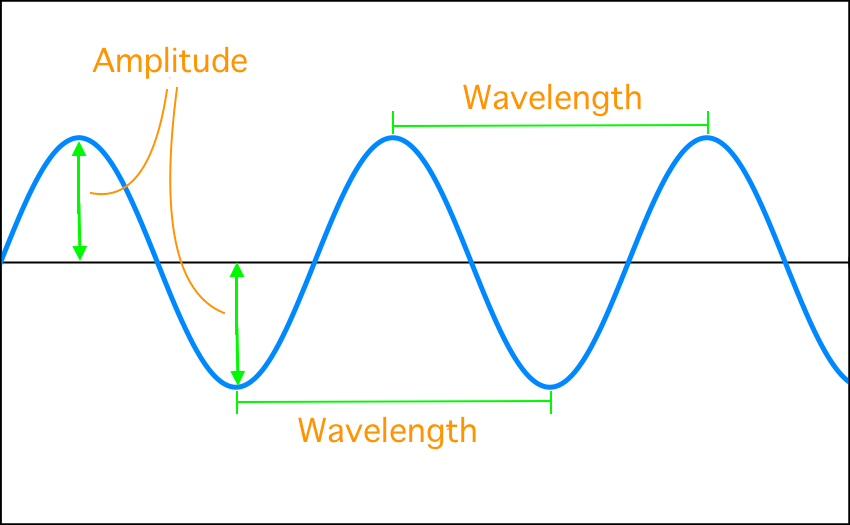
The same image is shown here with the amplitude and wavelength properties indicated.
Interference
Now imagine someone else also held the rope with you and moved their hand up and down the same amount as you and in time with you. What do you expect will happen? An important physical principle, called The Principle of Superposition, tells us that the resulting wave will be the mathematical addition of the two individual waves. This results in a pattern that will be doubly as higher and doubly as lower in the crests and the troughs, respectively. Observe this effect here:
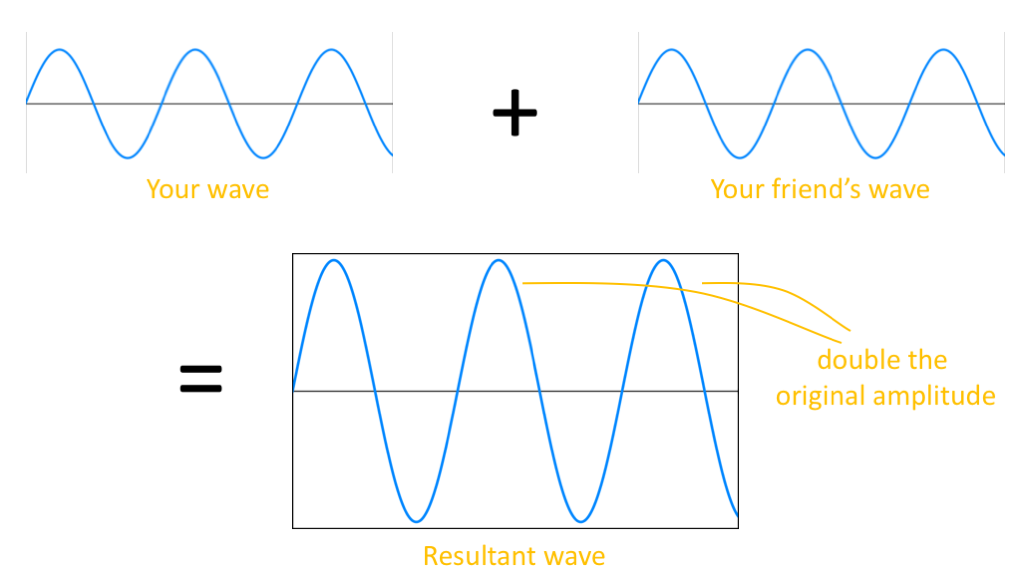
The two waves are added. At any point, the total 'height' from the zero line is given by the addition of the two heights from the two waves. This is known as constructive interference.
The fact that the waves add at every point results in a phenomenon called interference. The important thing to realise here is that your friend will not always move the rope up and down in time with you. And as such the waves will not always line up. In the particular case where your friend does move it in time with you, constructive interference happens. They could, however, decide to move it down as you're moving up and similarly move it down when you're moving it up. In this case, you two would cancel each other out and destructive interference would happen. This is demonstrated here:

Again, the waves are added. Because the waves are "out of phase", they cancel out and the rope does not move. This is known as destructive interference.
Constructive and destructive interference play a massive role in the double slit experiment and while there's more to say regarding interference in general, I think I have shown you enough about it to be able to move forward to our main points. I believe, in the future, I will be writing an article about The Principle of Superposition where I will be covering interference in more (possibly mathematical) detail.
There will be a small subsection explaining diffraction in the next section of this article, particularly in the context of the double slit experiment.
Young's Double Slit Experiment
Before the 1800s, there was much debate about whether light behaved as a wave or didn't. In comes Thomas Young and performs the double slit experiment showing that light behaves in a way that can only be explained by the wave model and interference as described above. We will explore how this experiment worked here.
Setup
The experiment is performed with a source of light, a plate (could be a piece of cardboard) with two tiny parallel slits carved in it and a screen that acts as a detector. There are two conditions that apply to the light source. The light source must emit coherent and monochromatic light. Because light sources (such a bulb or a candle, etc) emit multiple waves of light, rather than one, those waves must be in phase (or in time, as described above) and they must have the same wavelength. Being in phase is known as being coherent and having the same wavelength is known as being monochromatic. These conditions are satisfied by using a laser as the light source.
Diffraction in a nutshell
When waves approach a narrow opening (like a slit), they experience an effect called diffraction, where, after they pass through the opening, they "spread out", like shown here:
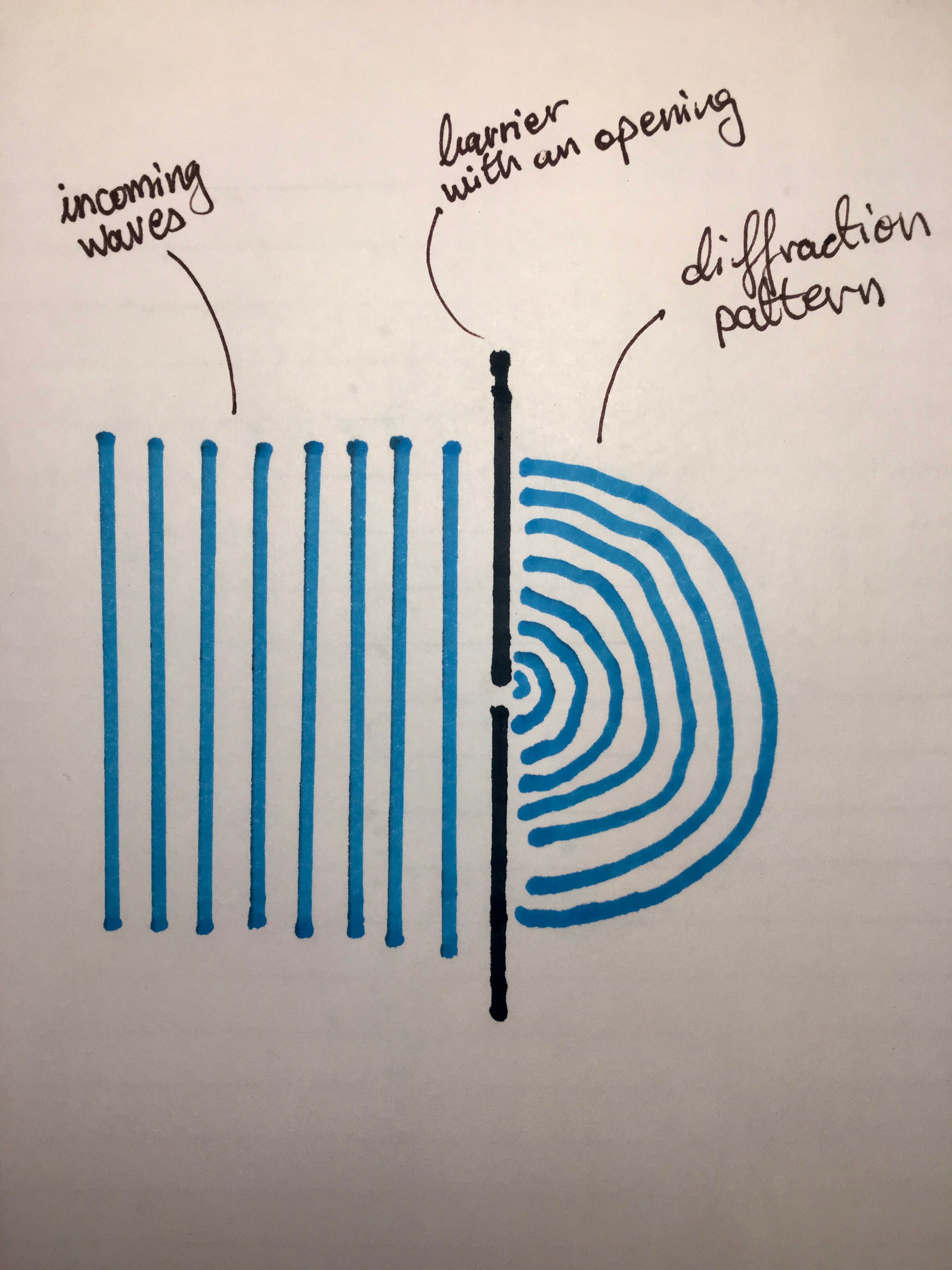
Light diffracting (spreading out) after passing through a narrow slit.
If we add a screen in front of the diffracted waves to detect them, we will see "columns" of light that decrease in brightness as they spread out left and right on the screen. This is due to the waves of diffracted light interfering with themselves, creating columns of high brightness when constructive interference happens and low (zero) brightness when destructive interference happens. This is better demonstrated here:
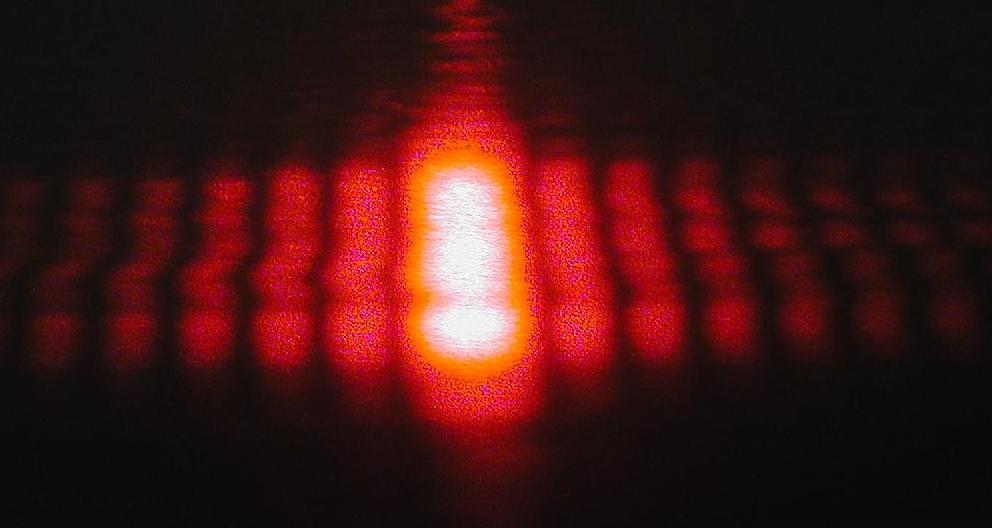
Result of light diffracting after passing through a single narrow slit.
Image from math.ubc.ca
The effect of diffraction can also be demonstrated with water waves:
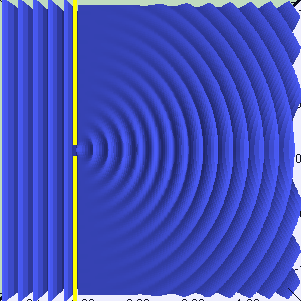
Water waves diffracting when after passing through an opening.
Image from scioly.org
Sometimes, diffraction will not happen. Whether or not diffraction occurs depends on the wavelength of the incident waves. The wavelength needs to be comparable to the size of the slit or opening through which the waves are passing. Otherwise, diffraction will not occur. This is important for when we talk about wave-particle duality of matter later. Just as a side note, diffraction can really be thought of as an effect of interference, but this is beyond the scope of this article.
Performing the experiment
To perform the experiment, the detecting screen is placed at a relatively large distance from the plate with two slits and the coherent monochromatic light is shone onto the plate, such that the light diffracts when it enters the slits. It diffracts in a manner similar to what's described above but this time it goes through two slits. This is shown here:
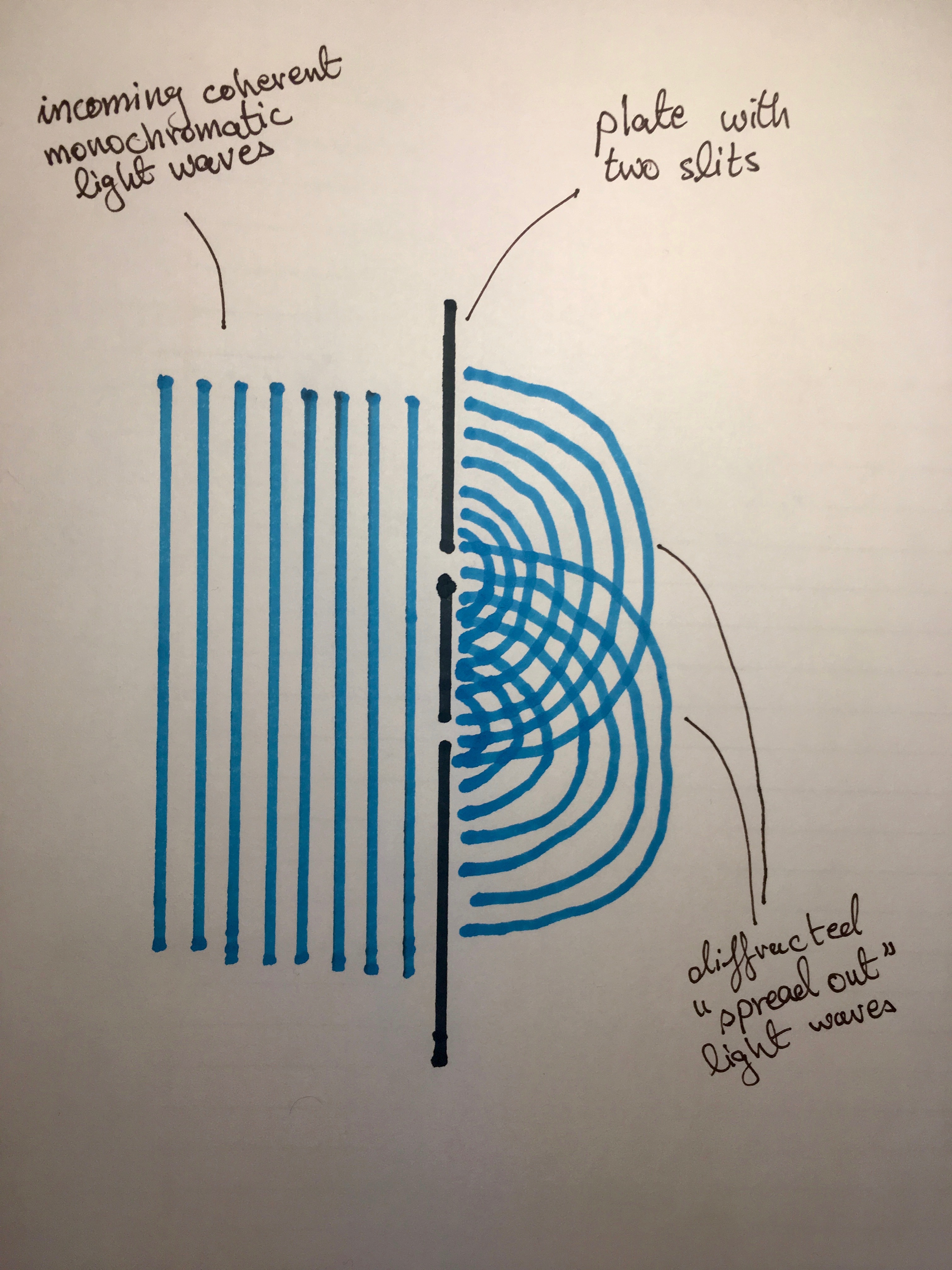
The incoming light diffracts through both slits causing two diffraction patterns to occur on the other side of the plate.
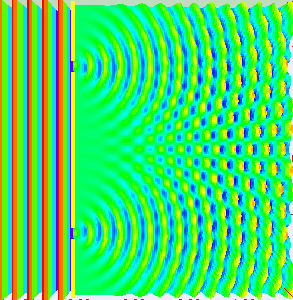
Diffraction from two slits. Notice how they arrive at the end. Interference causes the light to form bright and dark "fringes". Bright fringes occur when constructive interference happens and, similarly, dark fringes occur when destructive interference happens.
Image from Wikipedia
Eventually the diffracted waves will reach the detecting screen, where we'll be able to see where the light hits. Like described above with the one slit diffraction, the two diffracted wave patterns interfere and result in an interference pattern. The pattern is different to the one above though, because of the way that the waves interfere. This pattern will look something like this:

Result of light diffracting after passing through two narrow slits and interfering. This interference pattern is quite infamous in the world of physics!
Image from cnx.org
This phenomenon and why it happens is well studied and understood in optics. The waves resulting after diffraction from the slits interfere and, put in simple terms, where crest meets crest, high brightness is seen and where trough meets trough, low brightness is seen. The intricacies of this can be expressed in mathematical equations, but this is beyond the scope of this article. You can see the difference between performing the result with one slit and with two slits in this image:
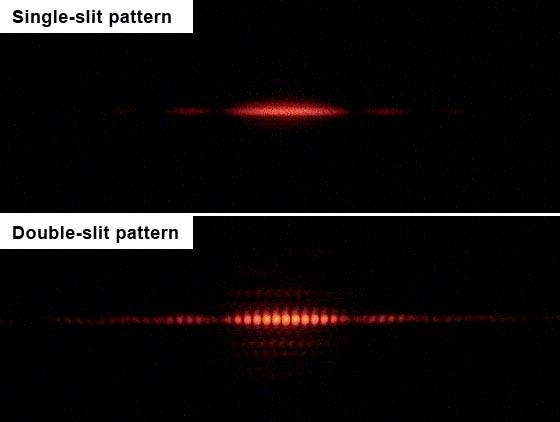
The difference seen on the detecting screen between one-slit and two-slit interference.
Image from Wikipedia
Conclusions of the experiment
This experiment definitively showed that light behaves as a wave because the interference pattern shown can only be explained by the wave model. It also shows the pattern that occurs when waves interfere in this way. This will be quite important in the next section because now we know that when we see a pattern that resembles this, then some sort of interference must have happened. And surely interference is a property of waves, not particles!
I have tried to not drag out the explanation of this experiment for too long as it is not the main focus of this article. However, I hope I have provided you with some understanding of what happens when waves pass through two slits (and one slit). This should come in handy as the modern double slit experiment is simply a variation on Young's original experiment.
Interlude: Marbles
Because performing the modern double slit experiment involves firing particles at the two slits, rather than shining light, let's first consider firing small marbles at two slits. This is because we said before that we imagine particles to be very tiny marbles. So perhaps we can imagine them behaving the same way. Of course, because of the weird beautiful way the quantum world works, they do not behave the same way!
Imagine having a machine that fires marbles at different random angles. You position it such that it's aimed at a plate with a slit carved into it. There is a screen on the other side of the plate to which the marbles can stick when they touch it.
It is easy to imagine the results of such an experiment. Some marbles will go through the slit and some will simply reflect off the plate. The ones that do go through the slit move straight and hit the screen forming a single column of marbles. It is also easy to imagine what will happen if we use a plate that has two openings rather than one. Each marble has three options: reflect off the plate, go through a particular slit or go through the other one. So we should expect to see the marbles forming two columns on the screen. This is shown in the following images:
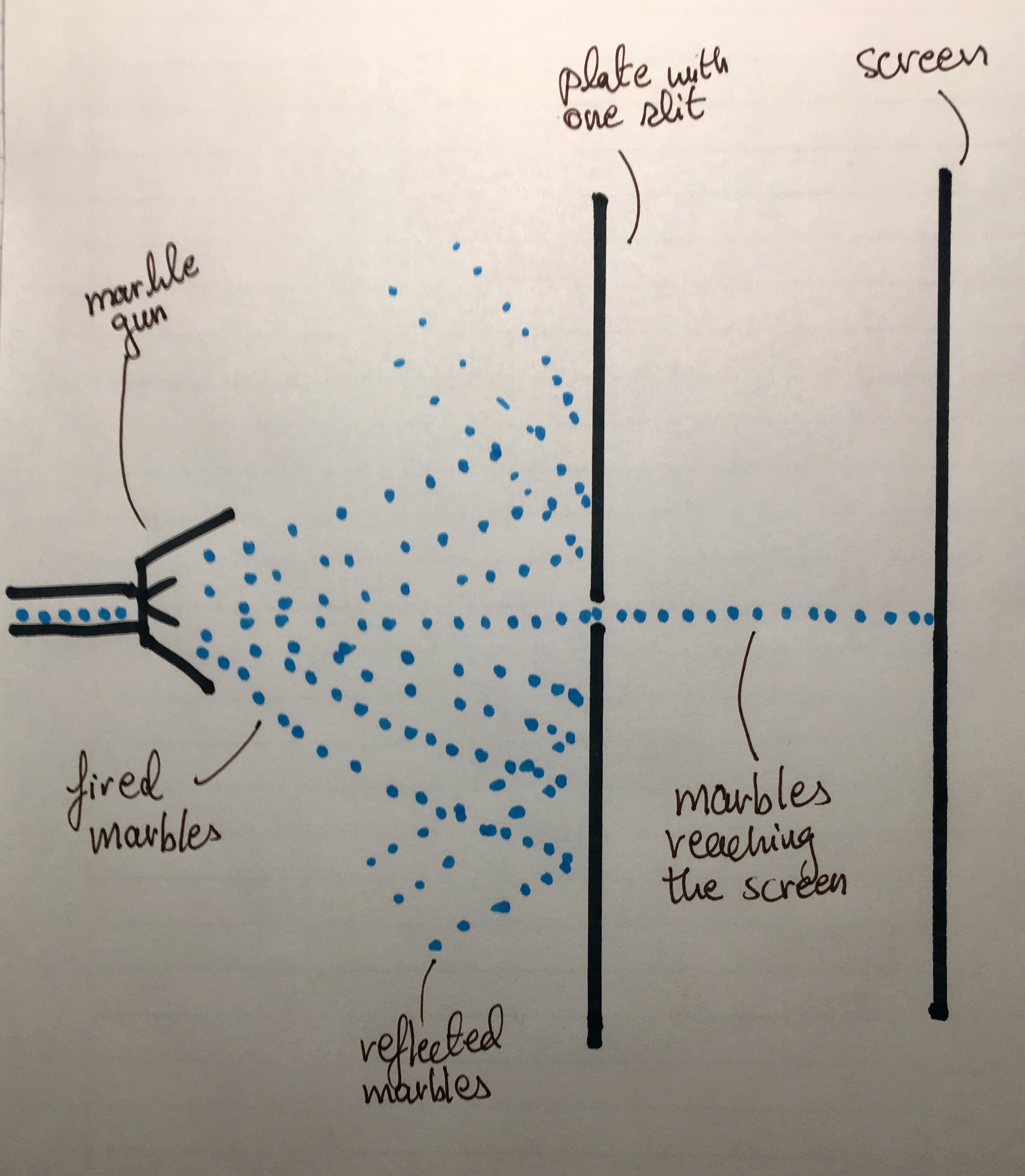
Setup showing a marble gun firing marbles at a plate with a single slit in it. The results are shown in the next image.
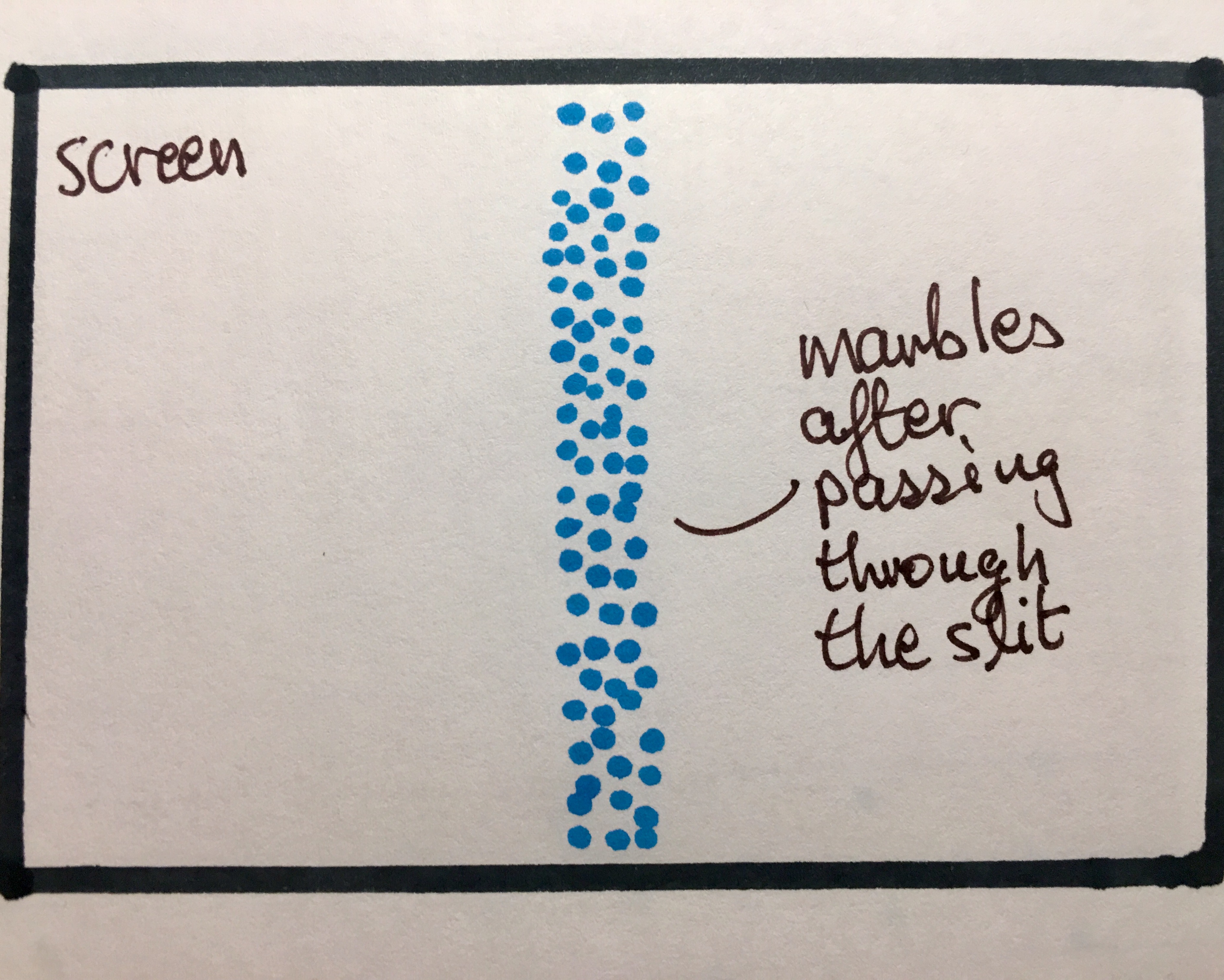
Resulting pattern on the screen: a single column of marbles, as expected.

Setup showing a marble gun firing marbles at two slits. Again, the results are shown in the next image.
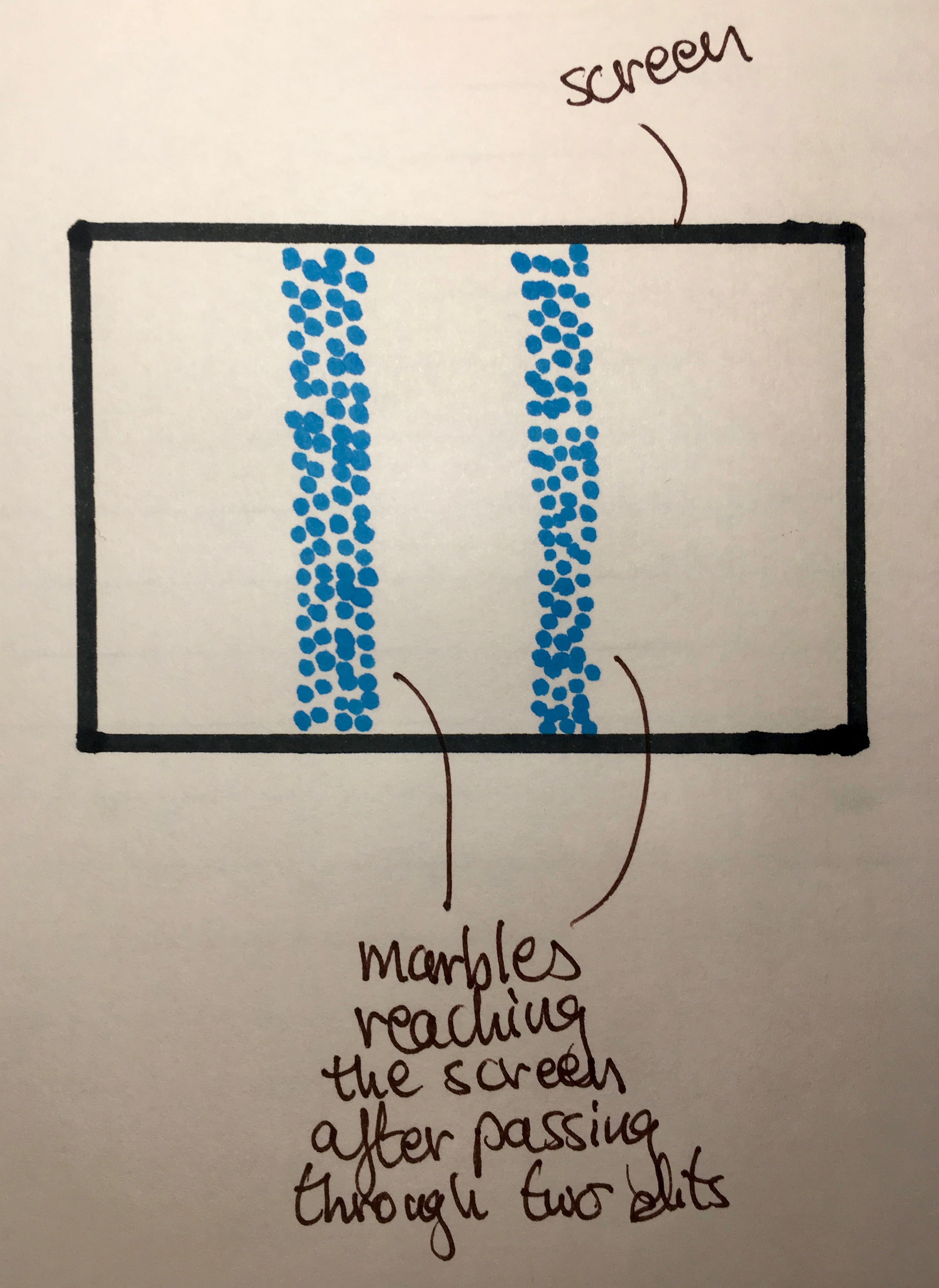
As expected, we see two columns of marbles on the screen.
The results of this simple experiment are fairly intuitive and are as expected. This is classical physics however, which we expect to behave intuitively. The quantum world, however, is more perplexing!
Performing the double slit experiment with electrons
This experiment provided great insight into the world of quantum mechanics. However, it really brought up more questions that it answered, some of which remain unanswered today. To start with, this section will mainly be about performing the experiment and presenting the results found.
Setup
The setup is very similar to the original double slit experiment, except instead of using a light source, we fire electrons towards the two slits. This is really the main difference here. Another difference however is that we need to replace the screen with something that can detect where electrons hit and give some sort of signal about their position.
Performing the experiment and results
Electrons are fired! What do you expect we should see on the detector on the other side of the two slits? Well, intuitively, because electrons should act as particles, we would expect a pattern similar to the one given by the marbles shown above. What we see however, is very different!
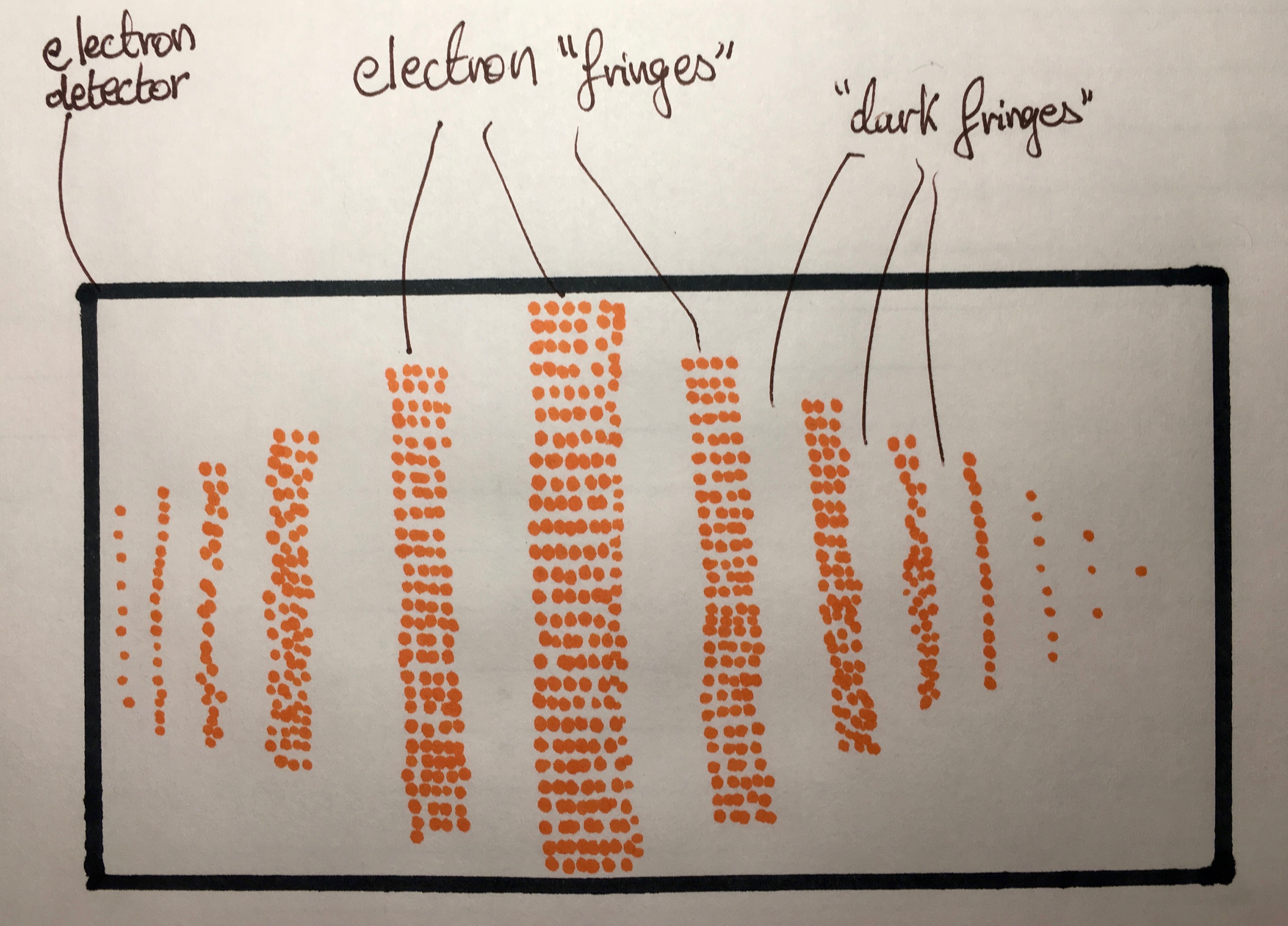
Completely different to what we would expect, a pattern similar to the interference pattern observed for waves is observed when electrons pass through two slits.
How could this be? Electrons are meant to behave as particles, surely! The only conclusion here is that the electrons behave as waves as they pass through the slits and they interfere with each other as waves . This was mind-boggling when first observed!
Well, since the electrons interfere with each, surely we can separate the electrons at the electron gun and fire them one after the other. This way the electrons have nothing with which to interfere after passing the slits. This takes significantly longer, but after an hour or so, we can see the results. Oddly enough, we observe the same pattern forming as time passes:
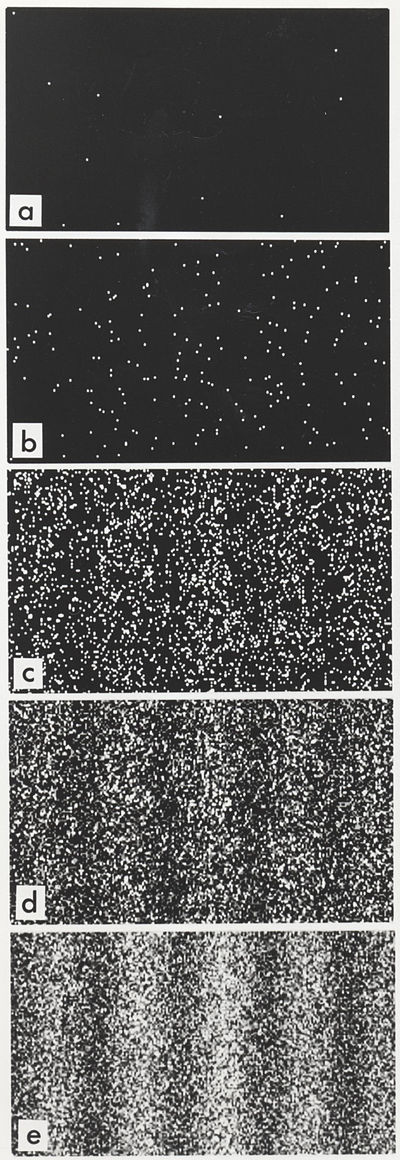
Firing single electrons and observing their build up over time. The same interference pattern is observed!
Image from Wikipedia
What does this mean? Another conclusion is then that a single electron acts as a wave as it goes through the slits, diffracts and then interferes with itself! This confirms that single particles are really waves! However, we know they are also particles because we fire them as particles, and they are detected on the other side as particles. This is a very important result in quantum mechanics: the wave-particle duality of matter.
A question you may be asking is 'so which slit do the individual electrons go through?'. A very good question which will lead us to really our main topic of this article: observers. The most straightforward answer is that electrons that actually pass the barrier will have gone through both slits, or in other words, we can't really know precisely which slit the electron goes through because of the Heisenberg Uncertainty Principle. This mainly results from the maths surrounding the particle and its representation as a wavefunction. This is, however, very much beyond the scope of this article. Interesting things start to happen when we begin to observe the electrons as they pass through the slits. But first, let's briefly consider this very important physical concept.
Wave-particle duality of matter
The double slit experiment conclusively showed that particles also behave as waves. So can we define wave properties such as wavelength for them?
Indeed we can! This comes from the work of Louis de Broglie who first proposed that particles can experience wave properties in 1924. This became formalised in the de Broglie hypothesis:
The De Broglie Hypothesis
Matter can behave as waves and an object has wavelength that is inversely related to the product of its mass and velocity (momentum).
These waves are known as matter waves. It is important here to define the wavelength of such waves because, if you recall, the condition for diffraction to occur is that the wavelength of the wave is comparable to the size of the slit or opening through which the wave is going. The de Broglie hypothesis tells us that the wavelength is inversely related to the momentum. This means that as the momentum (which is simply the mathematical product of the mass and velocity of the object in consideration) increase, the wavelength decreases. If the wavelength becomes too small compared to the size of the slit, no diffraction happens.
Why don't I diffract when I go through a door?
Because of the fact that you have such a high mass, compared to a subatomic particle such as an electron, your wavelength is quite tiny! In addition, the door is very much bigger in width than a slit. This is why you do not, indeed, spread out when passing through a door or any other kind of opening really! The fact that the de Broglie wavelengths of everyday objects is so small is the reason we do not experience these seemingly weird wave properties of matter in our everyday lives.
What about light? Is it a particle?
While the work of Thomas Young definitively showed that light behaves as a wave, other research showed that it behaves as particles, much like Newton originally predicted. Einstein's photoelectric effect required light to behave as a particle. And indeed, this effect was shown to take place. The conclusion being: much like matter, light also experiences wave-particle duality. There is much more to be said about the photoelectric effect but that will have to be another time.
Having considered this very important physical aspect, we can now go back to the double slit experiment and attempt to investigate the passage of the electrons through the slits.
Observing the electrons
UPDATE(13/05/2017): I have recieved some feedback about the information in the next few sections and it has been pointed out to me that I have misrepresented some of the results from performing variations of the modern double slit experiment. In light of this, I published a short correction post here and have striked through some of the information here.
Great! So electrons pass through the slits as waves. But why? In order to investigate, we can put some sort of detector just before the slits that has the ability to detect which slit a particular electron goes through. For the purpose of this, think of it as a very tiny camera that we can use to see the electrons.
So we set it up like this, and indeed we start observing the electrons go through a particular slit. So if they go through the left one, we can tell and if they go through the right one, we can tell.
A peculiar side effect of observation
We shouldn't expect the mere act of observing the electrons to change their path or behaviour in any way, should we? Oddly enough, experimental evidence shows that when the electrons are observed, they go back to behaving like the marbles above and pass through the slits as particles, almost as though they were never waves! We observe this pattern:

If we observe the electrons, they go back to behaving like particles and pass through the slits much like the marbles described above.
This is yet another mindboggling observation! Simply observing the electron changes its behaviour. This very strange behaviour has been studied quite well and is now well explained by the Copenhagen interpretation of quantum mechanics and involves the collapsing of the wavefunction of the electron, which is a topic for another time.
We can go one step further in this attempt to investigate this phenomenon. Can we make the electrons think that they're being observed by us, when, in fact, they aren't?
Let's "unplug" the camera
We can leave the detector where it is near the slits, but rather, let's not store or make any attempt at finding out what the detector sees. This means that despite the fact that the detector will detect something happening (an electron going through a slit), we, as conscious observers, will not come across the result of the detection in any way. What happens now?
Quantum mechanics does it again and the electrons go through the slits as waves, interfere and we see the familiar interference pattern:

It seems that if no conscious observer is involved in detecting the electrons, the wavefunction does not collapse, and the electron simply continues behaving as a wave.
Plenty of research has gone into researching this very strange phenomenon and this gave rise to multiple ways of interpreting it. All of the valid interpretations are mathematically accurate and correctly predict this behaviour. This means that they are all equally right! Or, in other terms, you cannot disprove one or more of them with only the data we currently have. The two most famous interpretations here are the Copenhagen interpretation and the 'many-worlds' interpretation.
We have already come such a long way in our research into quantum mechanics and physics in general, and yet, results like these seem to tell us that we're merely scratching the surface. There's much much more to be done!
How I like to think of it
Just from this very preliminary result of the experiment, it seems to me that a conscious observer is certainly involved and somehow influences the behaviour that physical entities take on. This is not saying that a conscious observer need not be physical! But as we do not really have much of an understanding of what consciousness really is, yet, there is not much we can say.
Indeed, I cannot really form a definitive "interpretation" of this because I have yet to truly study this phenomenon in detail (i.e. mathematically).
Despite this, I always like to think of physical phenomenon as possibly having a different way of being explained. Things which we may think to be quite peculiar right now may really turn out to be a part of a very much bigger framework that describes how something much greater works. History has many examples of theories explaining things a particular way only for that to turn out to be an approximation or a special case of something else.
Please take this lightly: as much as I like to think that we may eventually achieve the speed of light and travel the stars, I like to think that one day we will reach a definitive conclusive (possibly deterministic) way to explain all the seemingly absurd phenomena of quantum mechanics, possibly as part of a much greater framework!
One last thing: outwith but not completely unrelated to the physics
This is really more of a personal note, but I am a fan of the tv show, The Big Bang Theory. And I would just like to point out one thing. The very first line spoken in the first episode of the first season is Sheldon saying this to Leonard:
"So if a photon is directed through a plane with two slits in it and either slit is observed, it will not go through both slits. If it's unobserved, it will. However, if it's observed after it's left the plane but before it hits its target, it will not have gone through both slits."
Here, Sheldon speaks of a photon (the particle that makes up light) that is taking part in the Young's original double slit experiment. This again relates to the wave-particle duality of matter. If the photon is observed before it goes through the slits, it will act as a particle and only go through one. Otherwise, it continues acting as a wave, much like the electron does as described above.
The second half of the quote is referring to something called the quantum eraser experiment where researchers have attempted to observe the particle (either photon or electron) after it passes the barrier. Summarily, despite prior evidence showing that the particle does pass through the slits as a wave, it seems as though it decides to start behaving as a particle once it's observed. And not simply start to! It will pretend as though it had always been a particle; almost like it goes back in time and goes through the slits again but as a particle. This happens instantly though! Yet another incredible result of quantum mechanics.
Sheldon then goes on to make the point that he thinks it's a good idea for a t-shirt, a point with which, to be quite honest, I completely agree!
Conclusion
I feel like I have covered multiple topics with this article in rather brief detail. Despite this, I hope I have provided just enough detail about each aspect for you to be able to have a preliminary understanding of the results of the final experiment.
So do observers affect reality?
For the time being, it seems so. However, we really have no absolute definition of what constitutes an observer, so this result does not really tell us much about how the world works. It rather asks many more questions!
Closing remarks
I hope you have enjoyed this article about an experiment that really changed the way we think about the world, more than once! If you have any particular questions about this, please do not hesitate to ask in the comments just underneath this article. I would also very much appreciate your feedback. If you enjoyed something in particular or would like something done better next time, please do let me know as it will help to improve this blog. Also please consider subscribing if you would like to be notified of more articles that I publish.
Thank you for reading!
Related
You may also be interested in:
Particle Physics, Part 1: Why is the Standard Model so cool?